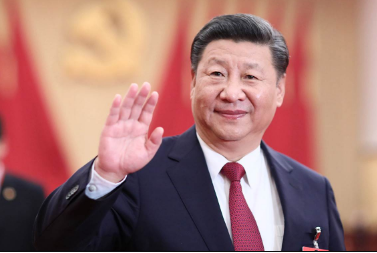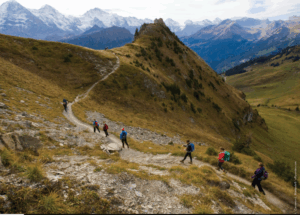“Toward Greater Progress of China-Nepal Friendship across the Himalayas” – Xi Jinping

A signed article by Chinese President Xi Jinping titled “Toward Greater Progress of China-Nepal Friendship across the Himalayas” published in Nepali newspapers ahead of his state visit to the South Asian country.
Toward Greater Progress of China-Nepal Friendship across the Himalayas
Xi Jinping
President of the People’s Republic of China
I will soon pay a state visit to Nepal, a friendly neighbor of China, at the invitation of President Bidya Devi Bhandari. The visit will be my first, yet the country is no strange place to me. I have long wanted to come to Nepal and see for myself its majestic mountains and rivers and unique culture. I have also met in China visiting Nepali leaders on many occasions and developed with them a deep friendship. I now very much look forward to stepping on this wonderful land to renew friendship and explore cooperation with my Nepali friends. I hope we can together draw up a new blueprint for our bilateral ties.
China and Nepal are close neighbors linked by the same mountains and rivers and enjoy a long-standing friendship. More than 1,600 years ago, the Chinese and Nepali monks Fa Hien and Buddhabhadra visited each other’s country and together translated Buddhist scriptures into Chinese. Their translation works have remained influential to this day. In China’s Tang Dynasty (618-907), Nepali Princess Bhrikuti was married to Tibetan King Songtsen Gampo, while the Chinese monk Huen Tsang visited Lumbini, the birthplace of the Buddha, and left many precious written accounts of his pilgrimage. Then in the Yuan Dynasty (1271-1368), Arniko, the renowned Nepali architect, led a group of artisans to China and presided over the construction of the White Stupa at the Miaoying Temple in Beijing among several magnificent structures over the country. These are but a few examples of our past interactions that have inspired a lasting friendship between our peoples.
Since China and Nepal established diplomatic relations in 1955, our two countries have respected each other and trusted and supported each other, setting an example of equality, friendship, and mutually beneficial cooperation between neighboring countries.
— China and Nepal are good friends sharing mutual respect and trust. Following the Five Principles of Peaceful Coexistence, we have successfully demarcated our boundaries, turning the great Himalayas into a real bond between our two countries. We support each other on issues of our respective core interests. Nepal stands firm in upholding the one-China policy and prohibits any force from using its territory for anti-China activities. China firmly supports Nepal in safeguarding national sovereignty, independence and territorial integrity and in pursuing a development path tailored to its national reality.
— China and Nepal are good partners for mutually beneficial cooperation. Nepal is China’s important trade and development partner in South Asia, with two-way trade reaching 1.1 billion US dollars and Chinese investments in Nepal exceeding 300 million dollars last year. Nepal has been an active participant in the Belt and Road cooperation, and is working with China on a number of infrastructure projects to build or upgrade highways, ports, airports and power plants. A trans-Himalayan connectivity network is thus taking shape, which will serve not just our two countries but also the region as a whole.
— China and Nepal are good neighbors benefiting from people-to-people exchanges. The Zhong Hua Chinese Buddhist Monastery in Lumbini stands as another symbol of our religious and cultural interactions. Nepal is the first South Asian country to be designated an approved destination for Chinese tourists. Between our two countries, there are about 60 flights every week, and over 300,000 mutual visits every year. Eleven pairs of sister cities have been established between the two sides. These growing exchanges have brought our people ever closer and added impetus to the development of both countries.
— China and Nepal are good brothers who always stand alongside each other. When a devastating earthquake hit Wenchuan in 2008, the government and people of Nepal made generous donations in support of the rescue and relief efforts in China. Likewise, in the aftermath of the massive earthquake in Nepal in 2015, the Chinese government and people rushed to the aid of Nepal by conducting big rescue operations and supporting post-disaster reconstruction. These are shining examples of how China and Nepal look out for each other like brothers do.
While the Nepali government and people are vigorously pursuing their vision of “Prosperous Nepal, Happy Nepali,” the Chinese government and people are making big strides toward the “two centenary goals.” With the aspirations and future of our people closely linked, it is only natural for China and Nepal to respond to the call of our times and step up cooperation for a better future. Working together, the two countries may do just the following:
— Deepen strategic communication. It is important that we adopt a strategic and long-term perspective and draw up a blueprint for our bilateral relationship to take it to a new height in this new era. We need to maintain high-level exchanges, enhance political mutual trust, and continue to render mutual support on issues concerning each other’s core interests. We may also have more exchanges and experience sharing on governance and development to deliver greater benefits to our two peoples.
— Broaden practical cooperation. We need to make greater efforts to develop a Multi-dimensional Connectivity Network across the Himalayas. China supports Chinese business investment in Nepal in the four priority cooperation areas of trade and investment, post-disaster reconstruction, energy, and tourism. China welcomes Nepal’s participation in the second China International Import Expo to promote exports of its specialty products to China. What’s more, China will continue to support post-disaster reconstruction and do what it can to support and assist the betterment of people’s lives in Nepal.
— Expand people-to-people exchanges. It is important that we encourage more exchanges and cooperation in such areas as education, youth and tourism, and support our airlines in opening more direct flights to increase mutual visits. China supports Nepal in hosting “Visit Nepal Year 2020,” and will encourage more Chinese tourists to visit Nepal. China will give more government scholarships to outstanding young Nepalis and help train more professionals needed in Nepal’s development endeavor. China welcomes more Nepali students to China.
— Enhance security cooperation. China supports Nepal in building law-enforcement capacity and will carry out law-enforcement training cooperation with Nepal. We need to scale up border defense contacts to fight transnational crimes more effectively and ensure the safety of our nationals and the smooth flow of trade. We also need to strengthen practical cooperation in mil-to-mil visits, personnel training, and equipment and technologies.
The Nepalis often say, “Drop by drop is the water pot filled.” There is also a Chinese saying: “The flame runs high when everyone adds wood to the fire.” I am convinced that as long as our two countries carry forward our tradition of friendship and keep increasing our exchanges and cooperation, we will together take our friendship across the Himalayas to a new height.
October 11 , 2019














